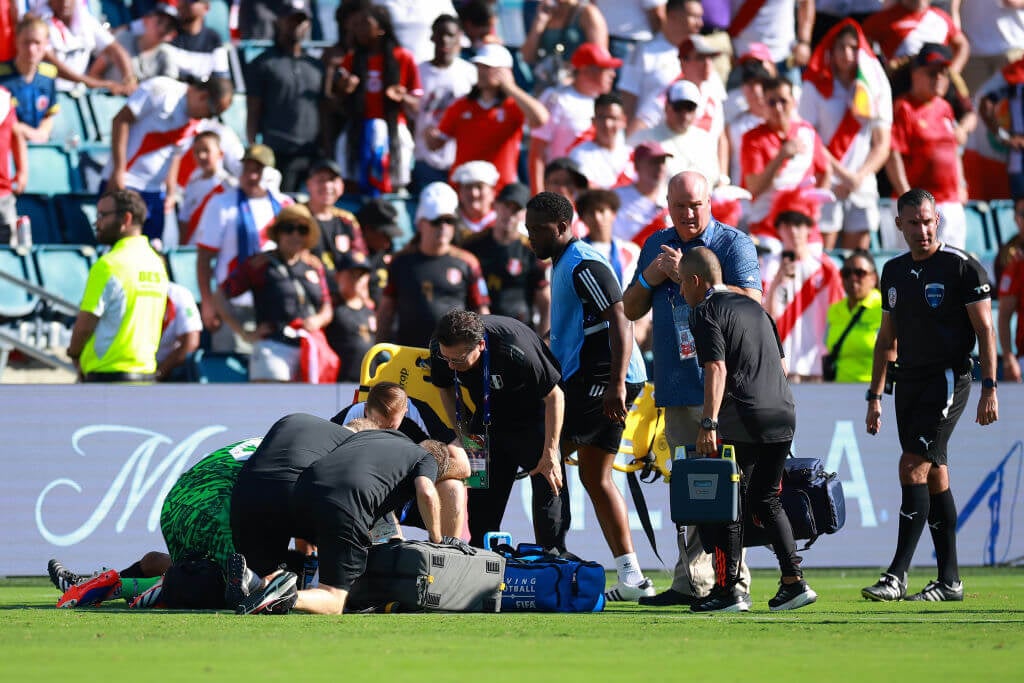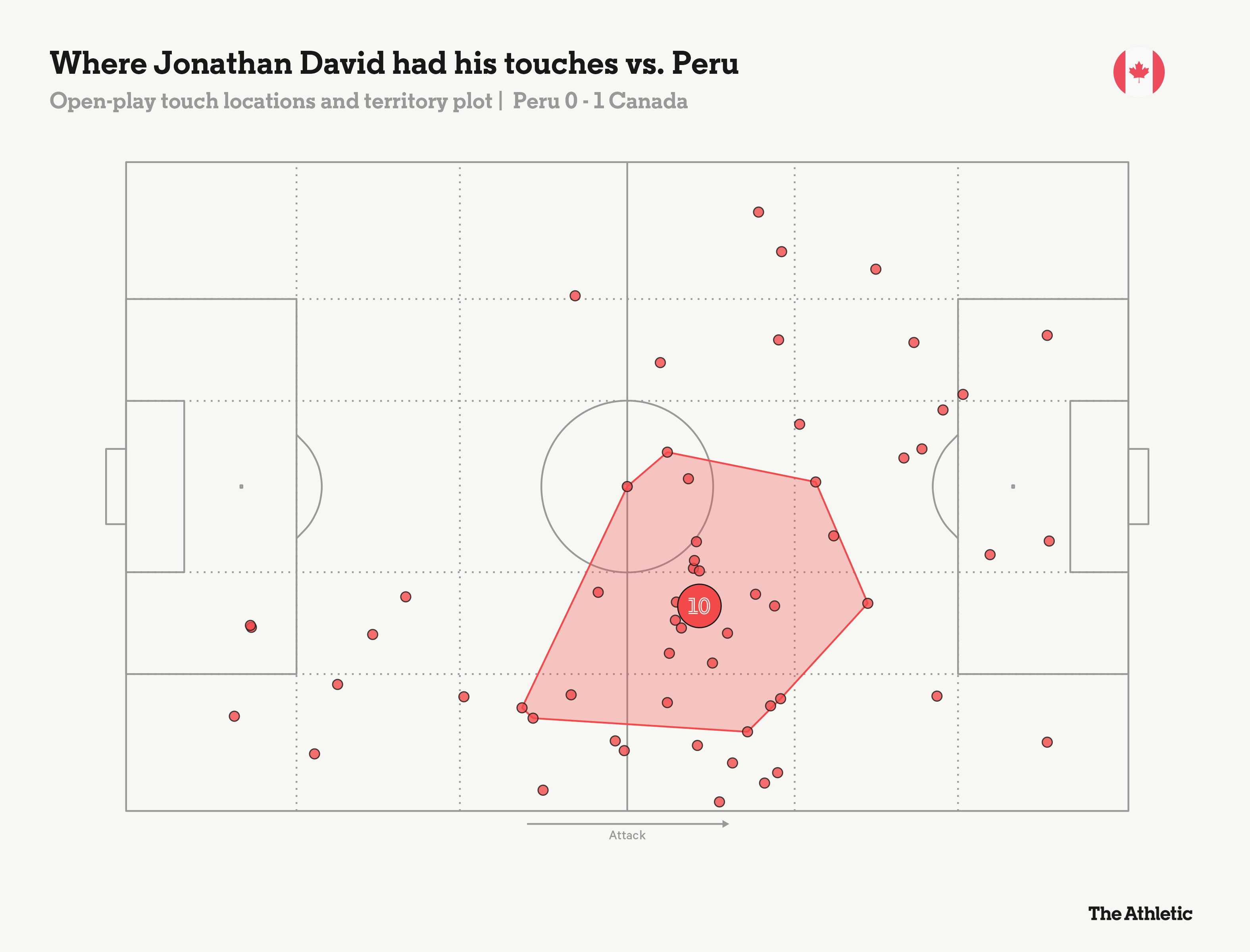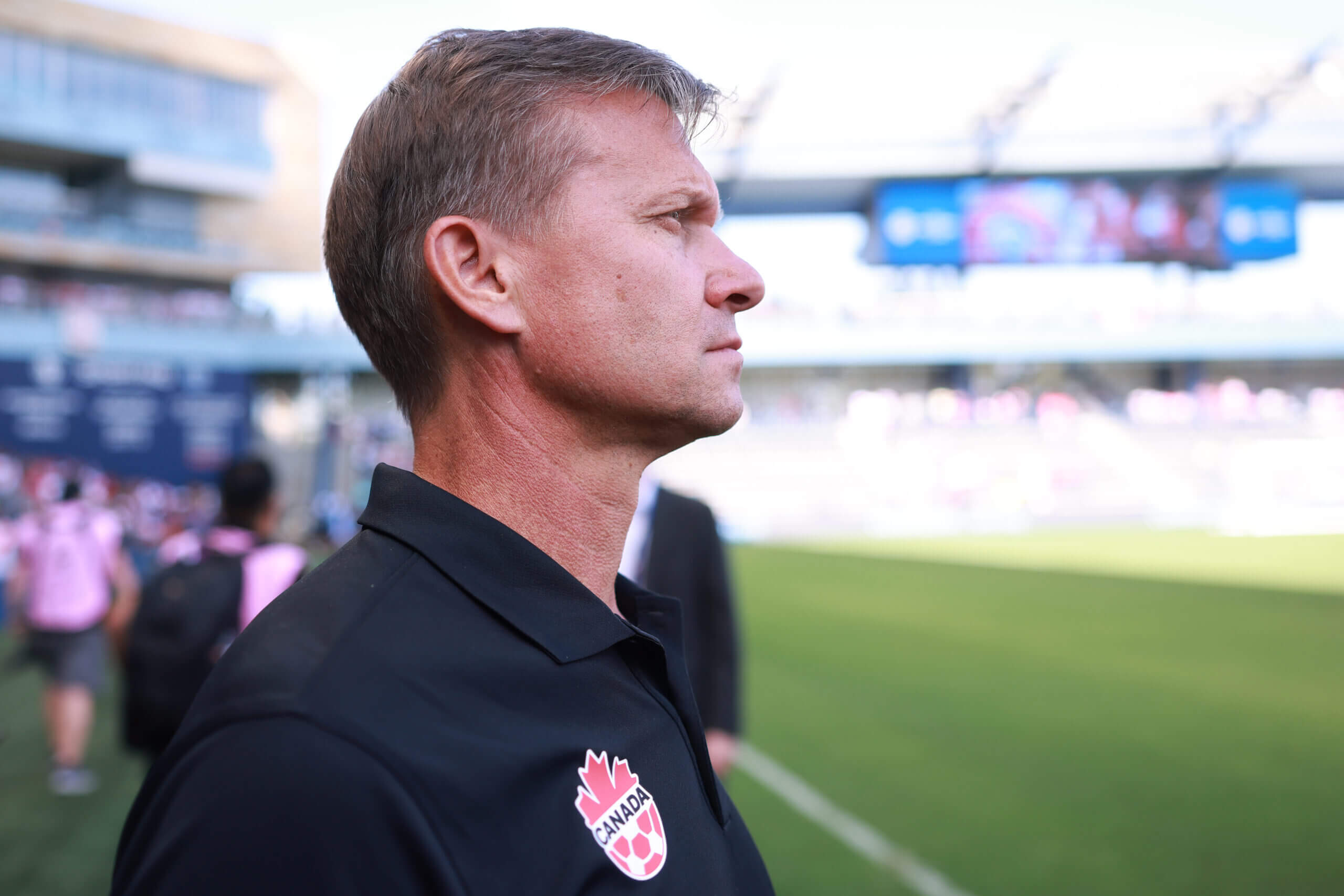After 344 minutes of play, Canada head coach Jesse Marsch finally saw one of his players score a goal. And it was the winning goal.
Amid an excessive heat advisory for Kansas City, Canada found a way to hold on and earn a crucial victory in a major international tournament thanks to a second-half goal from Jonathan David against a 10-man Peru .
But it wasn’t easy.
The sun beat down on the pitch at Children’s Mercy Park, its impact particularly visible when assistant referee Humberto Panjoj appeared to collapse, leading to a stoppage of play during injury time in the first half of the match. group A. Stretchers were immediately distributed to the linesman before he was treated by medical staff, taken off the field and replaced after half-time.
The first half also included a controversial non-call following a header, then in the second half Peru were punished with a red card for defender Miguel Araujo’s challenge on Jacob Shaffelburg.
Athleticism‘s Joshua Kloke shares his takeaways from the match…
What happened to the assistant referee at the end of the first half?
The heat has been relentless all week in Kansas City, with temperatures hovering around 100 degrees. A heat advisory was also issued in the city throughout the day.
During added time of the first half, as Canada was about to take a free kick in the Peruvian half, assistant referee Panjoj fell to the ground. Canadian goalie Maxime Crépeau was the first to notice and sprinted towards Panjoj. In doing so, Crépeau shouted at referee Mario Escobar to get his attention. The game was interrupted as stretchers were immediately brought for Panjoj.

Doctors assist Panjoj. (Photo by Hector Vivas, Getty Images)
About five minutes later, Panjoj was taken off the field on a stretcher.
For most of the first half, about two-thirds of the field was covered in shadow by the stadium’s curved roof. The section not covered in shadow was where Panjoj was to patrol.
At halftime, almost all fans seated on the west side of the stadium moved to the shaded areas as the stadium appeared to be half full.
How did Canada achieve its revolutionary goal?
The difference, at least on paper, between these teams lies in Canada’s individual offensive quality. Many of its best attackers play in the best European leagues. But for most of the match, many of Canada’s best players struggled to make an impact.
Until one of Canada’s best weapons – its speed – turned the tide in its favor.
On a quick counter-attack, speedy winger Shaffelburg, a half-time substitute, collected a pass and turned on the jets. By not thinking too much and sending the ball straight towards goal from inside the opponent’s half, Peru were caught off guard.
As he usually does, David timed his run perfectly to prepare for Shaffelburg’s long pass. After some smart touches, David then pushed a shot past Peruvian goalkeeper Pedro Gallese for the opening goal under Marsch.
Canada’s very first goal in the Copa América
Canada’s first goal in the Jesse Marsch eraJonathan David made Canadian history today
pic.twitter.com/eB0aME1Wdh
– FOX Football (@FOXSoccer) June 25, 2024
It was David’s 27th goal for Canada in his 50th appearance. He thus finds himself two goals behind Cyle Larin, the top scorer in Canadian history.
It always had to be David. Marsch maintained an unwavering admiration for his striker’s footballing IQ and his ability to keep a cool head when the game didn’t always go the way he hoped. David’s composure made the difference and served as a reminder of why he is currently sought after in the Premier League.


GO FURTHER
Canada Transfer Tracker: Alphonso Davies to Real Madrid? Jonathan David on the move
What is the impact of refereeing decisions on the game?
Referee Escobar had his hands full in a match that promised physicality well before kick-off. Peruvian coach Jorge Fossati said of Canada’s performance against Argentina that there was “a thin line between force and violence”, which appeared to be an attempt to curry favor with Escobar and to start practicing black magic a little earlier than necessary.
However, on the pitch, it was Fossati’s team which showed itself to be the most physical. How, for example, did Escobar not give Peruvian midfielder Marcos Lopez a straight red for headbutting Canadian defender Alistair Johnston in the first half? The question is mind-boggling when you add that the play was also reviewed by VAR.
Peru did not let up its openly fractious play in the second half as the heat persisted and tensions rose. Escobar ultimately used VAR to review Miguel Araujo’s potential foul on Canada’s Shaffelburg. A red card was awarded for the foul and Peru were sent down to 10 men. All credit goes to the Canadian team for keeping their cool even though the foul took place right in front of their bench. Marsch stressed before the match how important discipline would be for his team. They were the only team to practice it in the oppressive heat of Kansas City.
RED CARD
Peruvian Miguel Araujo receives a red card for this challenge after examination
pic.twitter.com/FxxhiHcQA9
– FOX Football (@FOXSoccer) June 25, 2024
Yet even with the numerical advantage, it took Canada time to make the most of its opportunities. Canada struggled to control the game in possession and generate any sort of creativity in their build-up until David’s goal. They will have to continue to create more opportunities to hope to escape from Group A.
What does this result mean for Canada?
Canada desperately needed a win under Marsch for a variety of reasons.
First, the tactical progress made in the short time since Marsch took office in May has been impressive. But this progress has come without results – or goals scored, for that matter – and this victory is a reminder of what can come from positive steps taken by Canada.

Canada earned its first victory under Marsch on Tuesday. (Photo by Hector Vivas, Getty Images)
The confidence Canada felt after holding France to a 0-0 draw in a friendly in June was good, but getting a result in a competitive match is another matter. They showed composure as tempers flared and Peru attempted to manipulate the match.
This result came against a team ranked 31st in the world by FIFA and should now be considered one of the greatest victories in Canadian football history. Canada has long believed that with the talent it has, it should be considered on the same level as teams like Peru. Now they have a result to prove it.
Now, Canada can feel even more confident heading into its final group stage match against Chile. With its first major tournament victory in a generation under its belt, Canada is in a good position moving forward.
What did the leaders say?
Jorge Fossati, Peru coach: “I don’t think it makes sense to play at this time with this temperature.”
“In the first half we challenged Canada more than Argentina did (in a 2-0 win last week). And I’m talking about Argentina, current world champion. We created more opportunities than against Chile. I think I can say that we created a superb 60 minute match.
Canada coach Jesse Marsch: “We talked about wanting to make a big statement, wanting to make history and show that we were ready to take on bigger challenges… And ultimately, with common sense from Peru, with the experience of Peru, to manage the whole match appropriately and keep our discipline and not cross the line, not put ourselves in danger of bad cards and fouls, that shows a level of maturity. I’m really happy for them. I’m really proud of them.
What’s next for each team?
Argentina vs. Peru — Saturday, June 29 at 8:00 p.m. ET/Saturday, June 30 at 1:00 a.m. UK (Hard Rock Stadium, Miami, Florida)
Canada vs. Chile — Saturday, June 29 at 8:00 p.m. ET/Saturday, June 30 at 1:00 a.m. UK (Inter & Co Stadium, Orlando, Florida)
Required reading
(Top photo: Hector Vivas/Getty Images)


